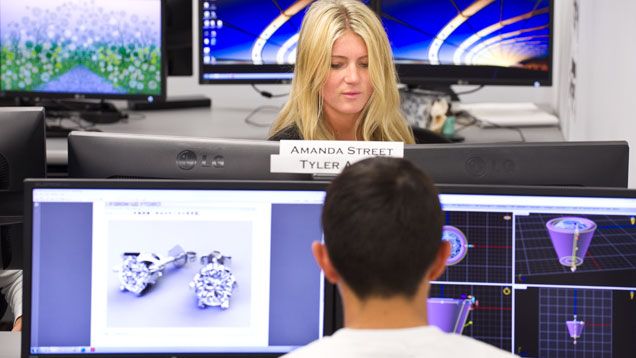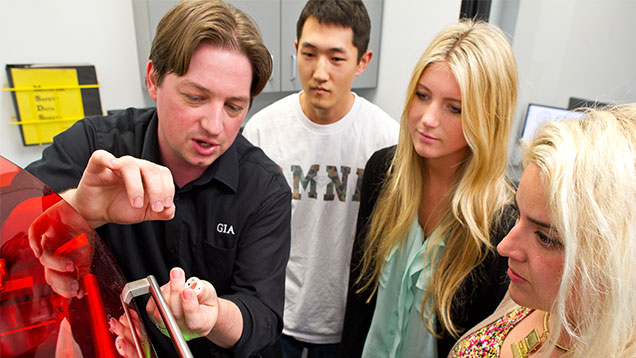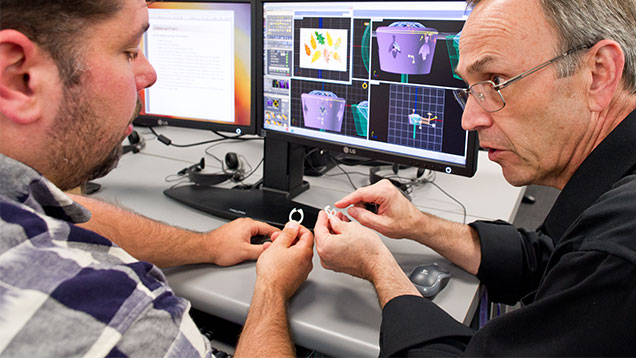Students Eager to Learn New Jewelry Design and Technology Techniques
April 23, 2013

“It’s trying to figure out how to retrain your brain to think in three dimensions,” said Hannah Becker, who started the course a month ago and has experience working in two-dimension as a photography and art history major in college. “We learn the basics – like making a square into a cube – and as we learn different tools and how they move, it’s been really intriguing to wrap your brain around.”
“There’s a lot of problem solving, so it does seem like a game sometimes. When I look at a form, I think ‘how would I create this shape, what type of movement would I have to envision to make this into an object.’ It’s kind of like a fun puzzle to solve for me,” she said.
Becker, who graduated from Bard College in Annandale-on-Hudson, New York with a degree in art history, wrote her thesis on glitter in contemporary art and was looking for a medium to channel her passion for sparkly things into a tangible career. She discovered the “concept of connoisseurship within the field of sparkly things” when she helped her brother shop for an engagement ring and learned about GIA.
She said she is enjoying the work in the JDT class because she is using both sides of her brain. “It’s like math, there is a right and a wrong answer, but we also have the creativity of it being design,” she said.
And that is the point of the six-month JDT course, said Mark Mann, GIA’s director of Global Jewelry Manufacturing Arts. Students learn all of the hands-on, practical tools they need to know to bring their artistic visions to life.
“The course not only offers CAD modeling techniques, they’re also learning jewelry design, engineering and manufacturing essentials. This jewelry manufacturing overview will assist them in successfully building functional products,” he said.
The redesigned jewelry arts classrooms in Carlsbad are outfitted with high-tech manufacturing and learning tools for efficient, visual and interactive education geared to today’s jewelry industry, he said.
“By incorporating the latest technologies, like rapid prototyping of designs using wax mills and 3-D printers, we prepare students for how the industry works today, which saves future employers time and money,” Mann said. “Graduates will enter the jewelry industry with up-to-date skills and unsurpassed learning experience.”

Instructor Michael Magee, left, teaches students how to use the Digital Wax 028 Rapid Prototype machine. Students, from left, are Tyler Abe, Amanda Street and Hannah Becker.
That includes the latest adult learning techniques that incorporate project-based, self-directed, experiential and action-oriented learning criteria. With these learning features in mind, each lesson contains a mix of tutorials on CAD design and modeling techniques, small group assignments, related development of personal design idea guidance, as well as footage from actual production facilities making products. Instructors lead them through the lessons and provide one-on-one help when needed.“We mix up the content to keep it more interesting, but it’s all related,” Mann said. The lessons build upon one another and include mandatory and practice homework. Students need to keep pace in developing their skills or they will fall behind, he said.
Tyler Abe, a former engineering student from Seattle, said the video tutorials are easier to follow than the print-based ones he used in his engineering classes.
“I took a CAD course for engineering and it took me about three months to learn probably what I learned in three weeks here,” he said. “Seeing how far we’ve come in one month and knowing that we have another five months to go, I have a feeling we’re going to be very proficient at this by the end of the class.”
Product spec sheets are a very important element of the class, Abe said, because that’s what the real world works with.
“I find it really enjoyable when they give us a spec sheet and ask us to create it,” Becker said. “They talk about CAD-think – training your brain so that when you see an object, you break it down into the steps: what is the start and what is the finish and at what point in the process you should be focusing on specific details.”
Amanda Street, from Fallbrook, California was searching for a career that would give her an opportunity to fulfill her art and design aspirations when she decided to attend GIA. The CAD/CAM lessons are fun because they are “like playing a video game,” she said, but “they are really preparing us” to work in the real world.
Becker couldn’t agree more.
“I feel confident that when I go to get a job, I will be really competent and proficient at doing things in a work-type environment,” Becker said. “It makes me feel like I will be able to create something that someone asks me to and I won’t have to worry about it being off. I’d like to know that if I’m asked to make something that will be cast in platinum that I’m not going to mess it up.”
The next JDT course will be offered Sept. 26 in Carlsbad and there are plans to make this program available at the Institute’s New York campus in 2014. Students can apply now.

Instructor Steve Roehl, right, reviews a prototype model of a ring with student Scott Sokolowski.
About the Author
Amanda J. Luke is a senior communications manager at GIA. She is the editor of the GIA Insider and Alum Connect and was the editor of The Loupe magazine.
.jpg)


